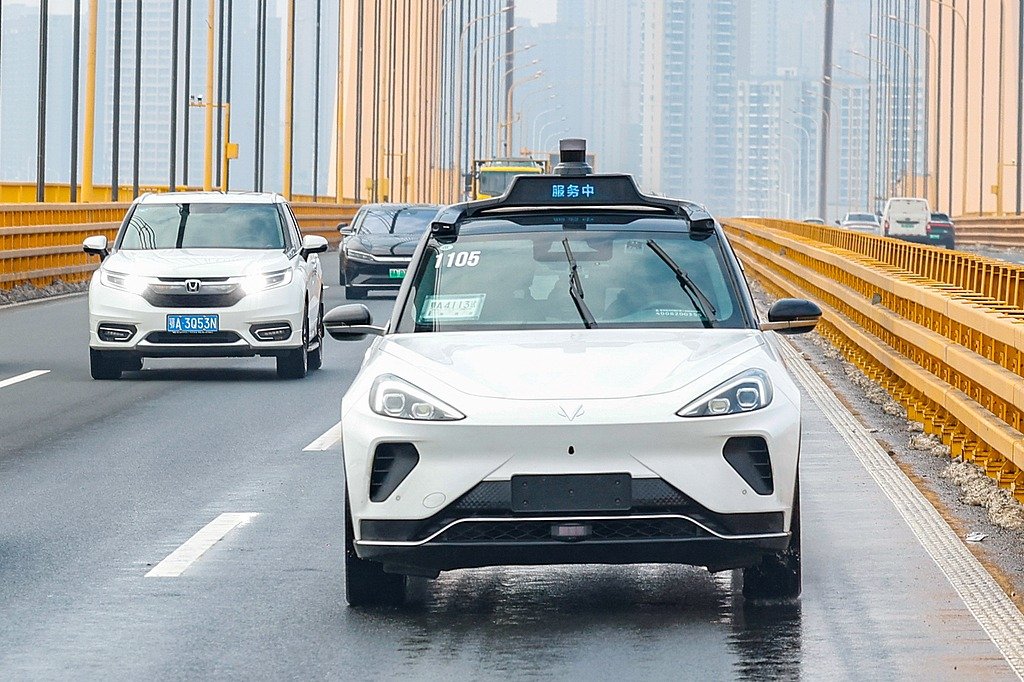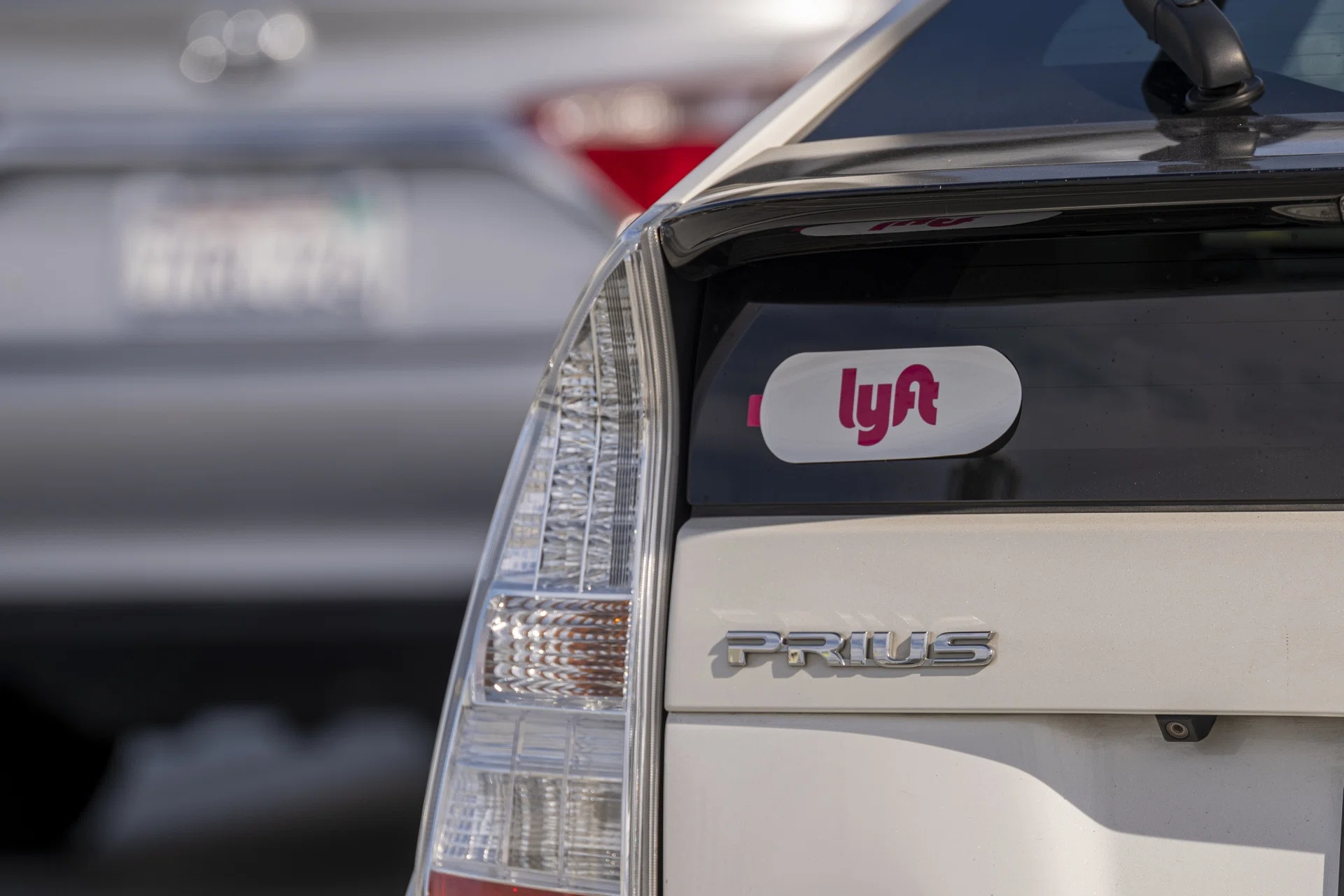Ride & Mobility
Apollo Go teams up with Lyft for Europe launch

Apollo Go, Baidu’s autonomous ride-hailing unit, announced a strategic partnership with Lyft, a global mobility platform, on Monday, marking a significant step in the Chinese tech giant’s international expansion.
According to the statement, Apollo Go will launch autonomous ride-hailing services in Europe via Lyft’s vast transportation networks by 2026. Using its sixth-generation autonomous vehicles, the services will first launch in Germany and the United Kingdom.
The partnership also envisions expanding the fleet to several thousand vehicles across Europe in the following years, driving large-scale commercialization of autonomous mobility in the region, the companies said.
“This collaboration with Lyft to launch autonomous ride-hailing in Europe, starting with Germany and the UK, is a major milestone in Apollo Go’s globalization strategy,” said Robin Li, co-founder, chairman and CEO of Baidu.
Li added that Baidu will continue to deepen the integration of its cutting-edge autonomous driving technology with Lyft’s operational expertise, delivering safer, greener and more efficient mobility experiences to users across Europe.
Lyft CEO David Risher also noted that as the Chinese tech heavyweight operates the world’s largest autonomous ride-hailing platform, the cooperation is expected to bring invaluable experience to the table.
“This means we can offer the benefits of autonomous mobility — safety, reliability, and privacy — to millions of users across Europe,” Risher said.
Apollo Go has been accelerating its global footprint through worldwide collaborations. Earlier this year, the company launched pilot services in Dubai and Abu Dhabi. More recently, it reached a separate agreement with Uber to integrate thousands of autonomous vehicles into Uber’s global ride-hailing network.
The tech player is also playing a growing role in advancing smart mobility and enriching cultural tourism in China.
Earlier this month, the company launched Hainan province’s first full-scenario autonomous ride-hailing service in the province’s capital city of Haikou, with pilot routes covering major cultural and tourist landmarks such as Holiday Beach and Qilou Old Street.
Local residents and tourists can conveniently hail a ride via a mobile app or WeChat mini-program and have the option of activating a Hainan-style voice assistant during the ride, according to Apollo Go.
“I used to just see autonomous vehicles online, now it’s actually in my city!” said a Haikou resident surnamed Yang.
“The ride was incredibly smart and user-friendly. You can even recline the seat and enjoy a massage. I can see that visitors are amazed by the high-tech vibe of transportation in Hainan,” Yang said.
“We hope smart mobility can ease travel congestion during peak seasons while offering a unique experience that reflects both the convenience of the free trade port and the laid-back lifestyle of Hainan,” said an official from the Hainan provincial department of culture, radio, film, television, publications and sports.
According to Apollo Go, the company has to date deployed over 1,000 autonomous vehicles across 15 cities globally, delivering more than 11 million rides, with domestic coverage including major cities such as Beijing; Shanghai; Guangzhou and Shenzhen in Guangdong province; and Haikou.
Fan Feifei contributed to this story.
lijiaying@chinadaily.com.cn
Ride & Mobility
Should Investors Bet on Uber Stock Post Q2 Earnings Beat? — TradingView News

On Aug. 6, San Francisco, CA-based Uber Technologies UBER released rosy second-quarter 2025 results, wherein both earnings and revenues surpassed the Zacks Consensus Estimate.
The question that naturally arises after the upbeat results is whether investors should rush and buy the stock of the company, which provides ride-hailing, food delivery and freight (leasing vehicles to third parties) services through its Mobility, Delivery and Freight segments, respectively, now. Let us delve deeper to answer the question.
Highlights of UBER’s Q2 Earnings
Uber’s second-quarter 2025 earnings per share of 63 cents outpaced the Zacks Consensus Estimate by a penny and improved 34% year over year. Total revenues of $12.65 billion outpaced the Zacks Consensus Estimate of $12.45 billion. The top line jumped 18% year over year on a reported and a constant-currency basis.
With economic activities normalized in the post-pandemic scenario, people are traveling to work and other places as before. As a result, UBER’s Mobility business has been seeing buoyant demand, with segmental revenues increasing 18% in the June quarter on a constant-currency basis.
With customer traffic picking up, gross bookings from the unit were highly impressive, aiding the second-quarter results. Gross bookings from the Mobility segment in the June quarter increased 18% year over year on a constant-currency basis to $23.7 billion.
Uber’s Delivery business also performed well in the quarter, with segmental revenues growing 23% year over year on a constant-currency basis. Gross bookings from the Delivery segment in the June quarter rose 20% year over year on a constant-currency basis to $21.7 billion.
Uber saw a 15% increase in its monthly active platform consumers to 180 million users in the second quarter. The platform recorded 3.3 billion trips, marking an 18% year-over-year rise, driven by both ride-hailing and delivery services. The company reported a free cash flow of $2.48 billion in the quarter, highlighting its financial bliss.
In several international regions, Uber Eats has overtaken ride-hailing in popularity. The company is focused on increasing cross-platform usage, encouraging customers to use both ride and delivery services to boost overall engagement and revenues.
The earnings beat by Uber in the June quarter enabled it to maintain its excellent earnings surprise record. Uber has outpaced the Zacks Consensus Estimate in the past four quarters, the average beat being nearly 200%.
Uber Technologies Price & EPS Surprise
Uber Technologies price-eps-surprise | Uber Technologies Quote
Uber’s Q3 Guidance Strong
For the third quarter of 2025, the company expects gross bookings of $48.25 billion to $49.75 billion, indicating year-over-year growth of 17-21% on a constant-currency basis. The outlook assumes a neutral to modestly positive foreign exchange impact.
The adjusted EBITDA is estimated to be $2.19-$2.29 billion, suggesting year-over-year growth of 30-36%.
UBER’s Price Performance Is Impressive
Uber has navigated the recent tariff-induced stock market volatility well, registering a 47.9% year-to-date gain, while the Zacks Internet-Services industry has moved up 5.9%. Uber’s main competitor, Lyft LYFT, has risen 8.5% in the same timeframe. Another industry player, DoorDash DASH, has performed better than Lyft and Uber year to date, soaring 53.9%.
YTD Price Performance Comparison
Uber Shares Overvalued
From a valuation perspective, Uber is relatively expensive. Going by its price/earnings ratio, the company is trading at a forward earnings multiple of 27.3, above the industry’s 19.8. The company has a Value Score of C. Meanwhile, Lyft looks too cheap at a forward earnings multiple of 11.25, whereas DoorDash’s P/E sits at 86.08. Lyft and DoorDash have a Value Score of C and F, respectively.
UBER’s P/E F12M Vs. Industry, LYFT & DASH
How to Play Uber Post-Q2 Earnings?
Agreed that Uber’s valuation is anything but tempting. The company’s high debt levels and concerns pertaining to currency represent further headwinds. However, not all is gloom and doom for this dominant ride-sharing company.
The company’s diversification efforts and shareholder-friendly approach are praiseworthy. Uber’s large size (market capitalization of $186.57 billion) positions it well to overcome turbulent times, such as the current one. Diversification is imperative for big companies to reduce risks, and Uber has excelled in this area.
The company has engaged in numerous acquisitions, geographic and product diversifications and innovations. Uber’s endeavors to expand into international markets are commendable and provide it with the benefits of geographical diversification.
Prudent investments enable Uber to extend its services and solidify its comprehensive offerings. Moreover, Uber aims to gain a stronghold in the highly promising robotaxi market through strategic partnerships. Uber now partners with 20 companies in the autonomous vehicle, delivery and freight space. By adopting this approach, the company has avoided the massive R&D costs associated with developing autonomous systems independently.
Uber’s scale, targeted market expansions and diversification strategies position it well for long-term growth. Given its solid long-term potential, retaining this Zacks Rank #3 (Hold) stock appears prudent. Meanwhile, new investors may consider waiting for a more attractive entry point.
You can see the complete list of today’s Zacks #1 Rank (Strong Buy) stocks here.
This article originally published on Zacks Investment Research (zacks.com).
Zacks Investment Research
Ride & Mobility
Lyft shares slide on weak sales, disappointing ride totals

[NEW YORK] Lyft shares slid in late on Wednesday (Aug 6) trading after the ride-hailing company reported revenue that fell short of Wall Street’s expectations, stoking concerns about its efforts to expand globally.
The company reported revenue of US$1.59 billion in the three months ended Jun 30, slightly missing analysts’ expectations of US$1.61 billion. And while the number of rides completed on the platform hit an all-time high, they too fell short of projections. Shares of the company were down about 7.2 per cent at about US$12.97 in after-markets trading.
The results landed just hours after Uber Technologies issued a better-than-expected forecast for the third quarter and exceeded Wall Street’s expectations on gross bookings. However, the company’s own ride-share unit recorded US$23.8 billion in bookings, falling slightly below expectations, also driving the company’s shares down on Wednesday.
The disappointing results of ride-hailing companies such as Uber and Lyft are offering a glimpse into discretionary consumer spending at a time when the economy is already flashing warning signs. Just last week, US employment numbers painted a much weaker picture of the labour market than previously reported, and inflation-adjusted consumer spending, which accounts for about two-thirds of US economic activity, fell in the first half of the year.
Lyft’s sales miss overshadowed what was otherwise a strong quarter. The company’s net income totalled US$40.3 million in the second quarter, more than double the US$18.1 million that analysts had expected. Gross bookings gained 12 per cent from a year earlier, roughly in line with estimates. The number of active passengers hit a record.
In the third quarter, Lyft said that it expects gross bookings to rise to as high as US$4.8 billion and projected adjusted earnings of US$125 million to US$145 million. The company’s outlook includes the integration of Freenow, the European taxi app it recently acquired, beginning Aug 1.
BT in your inbox
Start and end each day with the latest news stories and analyses delivered straight to your inbox.
Since attaining consistent positive free cash flow in the past year, Lyft has been working on growing globally. It has expanded into the ten most populous Canadian cities, as well as Puerto Rico. Last week, the company formally entered nine new European markets, including the UK and Germany, after completing its acquisition of Freenow.
As part of this expansion, Lyft announced this month a partnership with Baidu to begin deploying autonomous vehicles in Europe. Initial launches are planned for Germany and the UK in 2026, pending regulatory approval, with Lyft using Baidu’s robotaxis.
Last month, Uber announced a deal in which it will feature Baidu’s driverless cars on the Uber app, but the initial deployment later this year is planned for Asia and the Middle East, not Europe.
Lyft is also working towards offering its first driverless rides in Atlanta later this year with May Mobility. The firm’s also planning US deployments in 2026 with Intel-backed Mobileye Global and Benteler Group.
Lyft separately announced on Wednesday a new partnership that would allow United Airlines Holdings members to earn miles on rides. BLOOMBERG
Ride & Mobility
Unlocking Urban Mobility: What Israel’sRide-Hailing Market Needs Next

Israel’s urban landscape faces chronic traffic congestion, scarce parking, and limited public transit. High import taxes and complex regulations further complicate ride-hailing growth.
Yet even in this constrained environment, opportunities exist. As Eugene Suslo, CEO of Onde.app, puts it:
“Complexity doesn’t preclude progress – it needs operational flexibility and local understanding.”
Structural barriers to growth are real, though solvable
Public transport struggles with coverage and reliability, making private vehicles the default choice and worsening congestion. Car ownership is costly due to import taxes of up to 35%, environmental levies, and other fees. Security risks also affect ride-hailing economics, requiring strict safety protocols.
“There’s no single bottleneck,” notes Suslo. “It’s a layered problem. Solving it takes more than just an app.”
What’s needed to move forward
Experts point to reform and innovation despite these hurdles. Investment in infrastructure, such as Tel Aviv’s light rail, could integrate with ride-hailing services to reduce car dependency and improve coverage in underserved areas. Tax reform could also help modernize fleets, especially electric vehicles (EVs), which now receive government incentives.
Precise pick-ups, flexible rates between zones, and a smart route optimization algorithm improve operational efficiency, decreasing drivers’ idle times and passengers’ waiting times. Real-time analytics and AI recommendations for better performance ensure company growth, while safety features, which white-label ride-hailing solutions like Onde offer – drivers’ checkup, SOS button, Follow My Ride – guarantee a safer experience for both passengers and drivers.
“Our partners aren’t trying to outspend global giants,” says Suslo. “They’re building local trust and adapting to regional nuances.”
Insights from nearby markets
Operators who try to replicate global ride-hailing giants tend to struggle. Instead, hyperlocal, adaptable models often succeed. Onde’s experience across diverse markets – including in Israel’s Arab-speaking communities, where cultural and linguistic nuances require tailored approaches:
- NEMT: Onde’s clients in Eastern Europe partnered with healthcare providers to connect patients to clinics, especially in areas with limited public transit.
- Delivery-enabled ride-hailing: In times of COVID-19, crisis or conflict, delivering groceries, meds, or packages becomes a must-have. Onde sees growing interest in ride-hailing+delivery hybrids from Israeli prospects.
- Women-only services: While not widespread in Israel, such services resonate with specific communities, mainly Arab and ultra-Orthodox Jewish women, where cultural and religious norms call for women-driven, women-only transport. For example, this model helped build loyal user bases in Africa. In Israel, it remains a niche but meaningful segment, aligned with growing public discourse around safety and gender-sensitive mobility.
- EV-based fleets: Electrified fleets not only reduce costs over time but also align with Israel’s green mobility goals. Onde helps operators track energy usage and optimize charging.
Israel at a crossroads
The market is torn between structural and economic barriers and a tech-savvy population eager for better mobility options. Progress requires supportive regulation, infrastructure upgrades, and business models prioritizing local needs over global scale. With demand clear, the challenge lies in delivering solutions rooted in both code and context.
-

 Brand Stories2 weeks ago
Brand Stories2 weeks agoBloom Hotels: A Modern Vision of Hospitality Redefining Travel
-

 Brand Stories2 weeks ago
Brand Stories2 weeks agoCheQin.ai sets a new standard for hotel booking with its AI capabilities: empowering travellers to bargain, choose the best, and book with clarity.
-

 Destinations & Things To Do3 weeks ago
Destinations & Things To Do3 weeks agoUntouched Destinations: Stunning Hidden Gems You Must Visit
-

 Destinations & Things To Do2 weeks ago
Destinations & Things To Do2 weeks agoThis Hidden Beach in India Glows at Night-But Only in One Secret Season
-

 AI in Travel3 weeks ago
AI in Travel3 weeks agoAI Travel Revolution: Must-Have Guide to the Best Experience
-

 Brand Stories1 month ago
Brand Stories1 month agoVoice AI Startup ElevenLabs Plans to Add Hubs Around the World
-

 Brand Stories4 weeks ago
Brand Stories4 weeks agoHow Elon Musk’s rogue Grok chatbot became a cautionary AI tale
-

 Brand Stories2 weeks ago
Brand Stories2 weeks agoContactless Hospitality: Why Remote Management Technology Is Key to Seamless Guest Experiences
-

 Asia Travel Pulse1 month ago
Asia Travel Pulse1 month agoLooking For Adventure In Asia? Here Are 7 Epic Destinations You Need To Experience At Least Once – Zee News
-

 AI in Travel1 month ago
AI in Travel1 month ago‘Will AI take my job?’ A trip to a Beijing fortune-telling bar to see what lies ahead | China

You must be logged in to post a comment Login